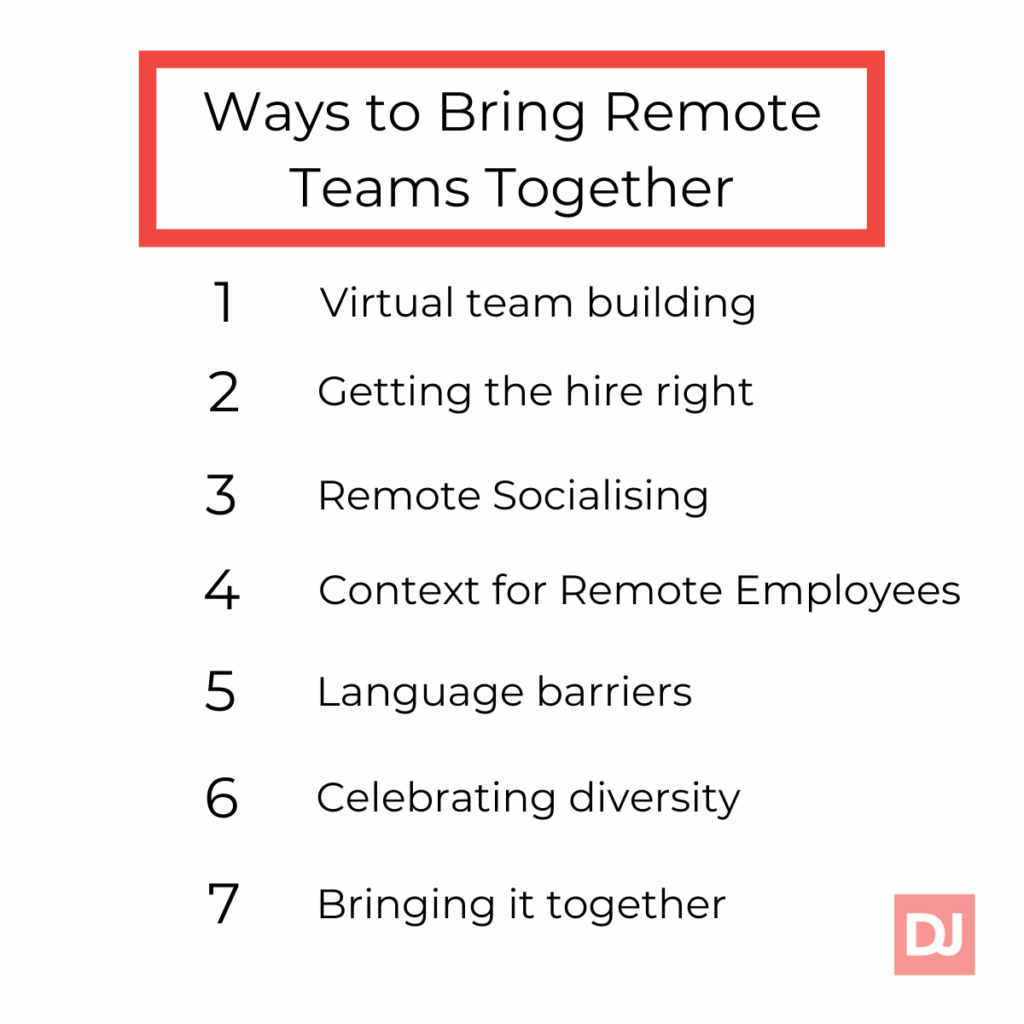Managing remote teams is a challenge that team leaders are increasingly facing. With telecommuting on the rise, teams are often spread across sites, states, or even continents. If you’re reading this, you’re likely aware of the advantages of remote teams, but perhaps you’ve also heard about some of the challenges. Remote jobs help employees to have a better work-life balance, but sometimes at the cost of positive relationships with their colleagues. For many leaders, their main challenge, besides encouraging effective communication, relies on how to bring a remote team together.
Psychological Distance in Remote Teams
Back in 2011, some researchers from Princeton published a paper called ‘Reducing Psychological Distance in Globally Distributed Teams’. They looked at how two different types of distance; geographical and heterogeneity (diversity, to us non-scholars), affected how distributed team members thought and felt about each other.
‘Psychological Distance’ is a way of measuring how connected with a thing, or person, someone is. You have a smaller psychological distance from people that you are familiar with, so when you think about them you see them as an individual. However, for remote employees who are from different locations, or come from disparate cultures, the psychological distance is greater. We’re more likely to generalize about them, thinking stereotypes instead of people.
So how can you bring your virtual team closer together?
Ways to Bring Remote Teams Together
Distributed teams have to re-think twice how to build strong connections. These connections often come naturally in on-site offices in water coolers or at the fun happy hours every Friday night. But in virtual teams, this doesn’t happen that easily. Leaders must come up with ways to build community remotely. This way, not only will virtual teams enjoy working together, but they will also be able to perform and communicate more efficiently. Here are 7 ways on how to unify a remote team:

1. Virtual team building
One of the best ways of connecting remote teams is by encouraging virtual team-building exercises. Think about your company and your team. Is there something your employees enjoy talking about? For example, at DistantJob, most of us love gaming. So, it’s easy to set up a gaming night once a while and have fun while getting to know each other. Or even create virtual happy hours and drink beers while talking about your favorite movies. Don’t let distance be an excuse!
2. Getting the hire right
Specialist recruiting agencies such as ours know how to find the perfect staff for remote IT jobs, those who have the right skills and temperament to thrive in virtual culture. Not everyone is cut out to work alone and manage their own time. You’ll need to look for employees who are self-disciplined and self-motivated, good communicators who are able to take criticism, particularly in writing.
It can be useful to start with a remote working trial for an employee and begin by establishing guidelines for what they need to do and when; in effect, a service level agreement. It’s easy to be on your best behavior for one trial, so it’s always worth repeating just to confirm the employee can deliver. Once you’ve got them up and running, keep monitoring for progress – if you get an employee who is continually missing deadlines or unavailable for questions then they may not be suited to working remotely.
Once you have a team, bringing them together needs an investment of time.
3. Remote Socialising
If there are disadvantages of virtual teams, one is that communication can be all business. There’s no bumping into each other at the water cooler or casual banter over the cubicle wall. Teleconferences tend to get straight down to business. To counteract that, add in some extra time to video conferences for a chat. Emulate an on-site meeting where attendees make small talk until the chair calls the meeting to order.
You could also use professional social networking sites such as LinkedIn or Yammer to connect your team outside of meetings, or even schedule virtual coffee breaks with no work agenda at all. Jason Thompson, the founder of 33Sticks, encouraged employees to work in teams and to sign up to Yammer through an internal marketing strategy. He described it as a virtual water cooler, crediting it with bringing his remote employees closer.
4. Context for Remote Employees
The Princeton study found that you could decrease psychological distance by giving more of the context around a team member. There’s often very little you can learn about a person from their background in a video conference, in fact, most tips for video conferencing include keeping your backdrop neutral and professional.
Asking employees to take you on a virtual tour of their office, or home can help colleagues identify with each other more closely. Alternatively, ask team members to submit photographs to be shared during a meeting ensures that everyone on the team has the opportunity to talk a little about themselves, or something going on in their lives, to their colleagues.
Another approach is to start a call with an icebreaker question or a poll, something that enables you to lead a discussion on the team’s similarities and differences; either way, these are things that your team can bond over.
5. Language barriers
Perhaps the most obvious barrier to virtual team building across oceans is language. Although many remote workers speak English fluently, there is still the question of accents, buzz words, and localized idioms that can make translating difficult. If your team includes members who have a different first language then it can be helpful to set some guidelines for language to be used in conference calls.
A written agenda is invaluable, and it’s great etiquette to send any presentations or supporting documents ahead of time so that others can prepare. It’s also a good idea to build in regular pauses and frequent summaries to ensure that everyone participating is following the discussion.
6. Celebrating diversity (literally)
Building a remote working community is also about celebrating diversity. Different cultures have different holidays. Promote understanding of different cultures by celebrating them—or kill two birds with one stone and ask one of the local employees to take some photographs or videos to better explain the celebration to the rest of the virtual team.
7. Bringing it together
Perhaps more important than anything, is having a strong team identity. When staff who work remotely start to see themselves as all being part of something, a lot of that psychological distance disappears. Having a team name, motto, or even a ‘coat of arms’ can all help to create viable team cultures: it builds ‘us’ rather than ‘them’.
Building a shared identity takes time and effort, but answering the question, ‘Who are we?’ often helps lead to ‘and what do we do?’ Borrowing from sales and marketing and using techniques that are helpful for building a brand are all useful in creating a team identity.
Virtual Team Management is evolving. As technology changes and makes the world smaller, we need to find new ways to connect with each other, to make the physical distance disappear. With more than 80% of employees saying they’d like to telecommute at least part-time, is known for an excellent virtual culture that will attract the brightest and best candidates for remote jobs, and that can only be a good thing for your business.
If you’re looking to overcome some of the challenges arising from a dispersed workforce, we can help. DistantJob supports organizations of all sizes and locations to manage remote working effectively, so your dispersed team becomes an attribute, not a liability. Get in touch today, to find out more





